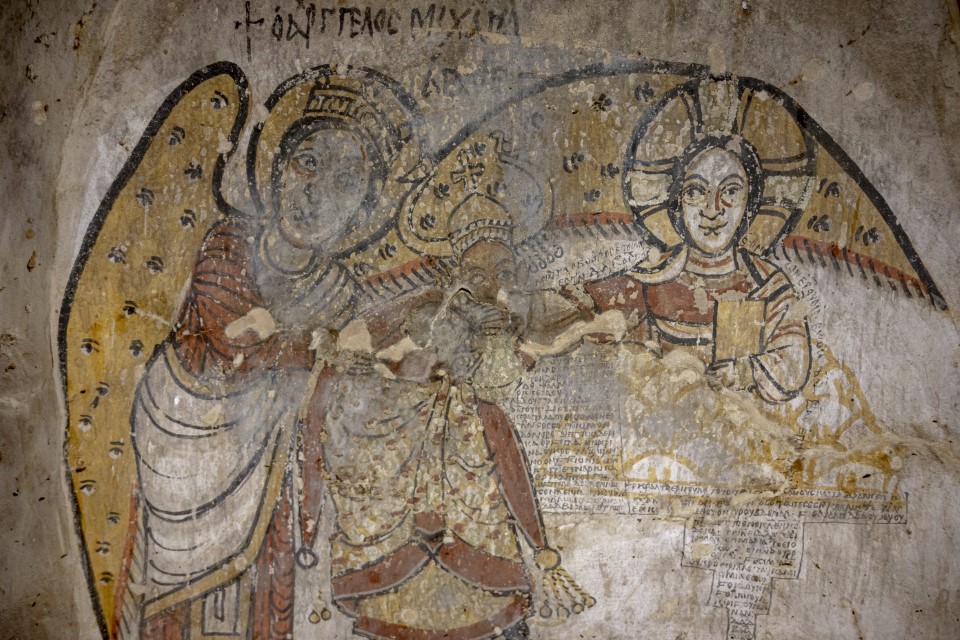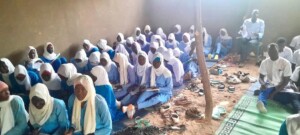Archaeologists discover ‘probably 13th century’ Christian art in northern Sudan

One of the paintings found in Old Dongola, called Tungul in Old Nubian (Photo: PCMA UW)
OLD DONGOLA –
Archaeologists from the Polish Centre of Mediterranean Archaeology, University of Warsaw (PCMA UW), have made stunning discoveries in Old Dongola (Tungul) in Sudan’s Northern State. This year, the Polish team discovered a complex of rooms made of sun-dried bricks, the interiors of which were covered with murals showing figural scenes of early Christian art.
“Seems that the god of excavations favoured us. We found not only the stone blocks from walls and floor of a Napatan temple of Amun of Gem-Aton (Kawa) but also enigmatic complex of chambers covered with murals and inscriptions dating to probably around 1276 CE,” Artur Obluski, the director of the PCMA UW, said in a tweet on Thursday.
The archaeological team reported last week that the murals within showed the mother of Christ, Virgin Mary, in a dignified pose, holding a book and a cross in her hands and dressed in a monochromatic dark robe – a representation unknown before in Christian iconography.
Another painting discovered represents King David of Makuria in an intimate and dynamic scene with archangel Michael whose spread wings shield both the king and Christ. The king bows to Christ, who is seated in the clouds and kisses his hands probably begging for protection of Tungul, the capital of Makuria.
“These wall paintings negate a bias that Africans tried to copy art from the North. They were creative adapting not only adopting world trends to their needs thus the new paradigm should be Nubio-and Afrocentric,” Obluski added on Thursday.
Engaging local communities
Excavations in Old Dongola began in 1964, after the conclusion of the International Campaign to Save the Monuments of Nubia. Over the next 50 years, the works conducted on the site resulted in the discovery of several monumental churches, a palace and two monasteries. Two years ago, a community engagement project called Dialogue started in Old Dongola in order to connect archaeological missions with the local community and Sudanese archaeologists.
“In the history of archaeology in Sudan it was often foreigners who excavate and research the Sudanese past but archaeological sites are the heritage of Sudanese people and often local communities have the knowledge about their sites through lived experiences so it is very important to integrate scientific and local knowledge to better understand this wonderful heritage,” Dr Tomomy Fushia, Assistant professor at PCMA UW said (see video). She further added that they are working together with the National Corporation for Antiquities & Museums (NCAM) in Sudan and the local communities in order to nominate Old Dongola to the UNESCO list of world heritage sites.
History revisited
Gem-Aton, currently Kawa, a site east of the Nile River, was a historic town that flourished 1500 BC and its ancient name refers to the pharaoh Akhenaten. Old Dongola, originally named Tungul, was the capital of the Kingdom of Christian Makuria from the 5th to the 14th centuries and is located at the downstream end of the Nile.
The recent discoveries of the Polish mission raise many questions, such as how the bricks of Gem-Aton discovered reached Old Dongola or what the historic relationship was between Old Dongola and Gem-Aton.
On April 20, an online seminar is planned by the director of the Polish Centre of Mediterranean Archaeology (PCMA) to showcase the preliminary results of the discoveries and discuss findings.











 and then
and then